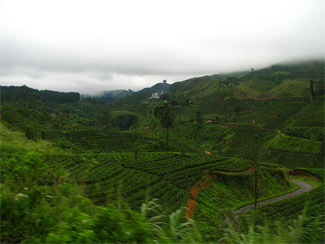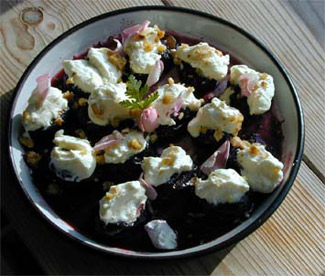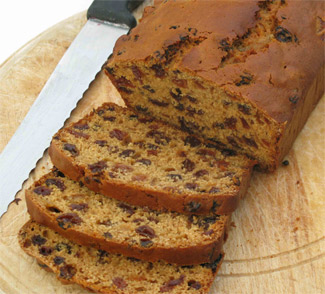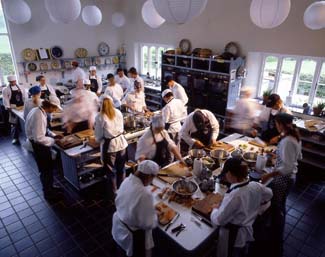The Darina Allen Column - Sri Lanka
 We love our cuppa in Ireland and are still drinking more tea per head than any other country in the world. Sadly though, nowadays most cups of tea are made from teabags rather than good loose tea which I am totally convinced makes a far superior brew. On a trip to Sri Lanka in 2010 I visited Handunugoda Tea Estate only a few miles from Galle, Mr Gunaratne whose family have been tea planters for 400 years, proudly showed us around.
We love our cuppa in Ireland and are still drinking more tea per head than any other country in the world. Sadly though, nowadays most cups of tea are made from teabags rather than good loose tea which I am totally convinced makes a far superior brew. On a trip to Sri Lanka in 2010 I visited Handunugoda Tea Estate only a few miles from Galle, Mr Gunaratne whose family have been tea planters for 400 years, proudly showed us around.
In 2008 Sri Lanka overtook Kenya as the second most important tea producing nation after India. Annual production of Ceylon Tea (as Sri Lankan tea is called) is about 330 million kilograms and enjoys premium prices at the tea auctions in Colombo. Tea has been grown in Sri Lanka since 1869 shortly after the coffee crop was decimated by disease. The industry employs 3.5 million people and is the largest foreign income earner and the largest employer.
As a cook I am always fascinated to learn how our food is grown. I’m particularly intrigued to learn about foods not grown in our climate so part of my holidays will invariably be spent learning about spices, exotic fruit, street food, wine… depending on the part of the world.
Not everyone’s idea of a fun holiday but I find it fascinating. Tea grows in altitudes between 100 and 5000ft. The gardens I visited were at just 100ft (30 meters) and specialised in white tea camillia sevensis. The tea bushes look like a green waist-high lawn. Tea in its natural state grows in the shade, so the tea gardens are punctuated by tall Ghrisidia trees which provide shade and attract birds to eat the unwanted insects. Rubber trees grow where tea doesn’t.
The brightly dressed tea pickers were already in the gardens when we arrived, all women, working at lightning speed, expertly plucking the tender leaf tips with their finger tips and flicking them into the basket strapped to their backs. The Tamil Plantation workers are contracted to pick a minimum of 20 kilograms a day and receive a bonus for any extra picked. The tea bushes are pruned to one meter in height every five weeks for ease of picking.
The freshly picked leaves are first withered by blowing air through them sometimes on hessian mats or on modern mechanical troughs. The partly dried leaves are then crushed which starts a fermentation process – the skill is to know when to stop this process. The technology and machinery is largely unchanged since the 19th Century, the crusher at Handunugoda Tea Estate had a brass plate Siroco Davidson and Co Ltd Belfast Ireland.
The leaves for white tea are not picked but snipped with golden scissors so they are untouched by hand. Mr Gunaratne explained that originally in China the Mandarins insisted that the leaves for white tea were snipped by virgins with gold scissors into a gold bowl. Body sweat contaminates the flavour. The Mandarins were convinced that white tea had extra attributes. More recently their white tea has been scientifically analysed by the Swiss company SGS and was found to have 10% to 11% more antioxidants than any other tea and in white tea the caffeine content is very low. It also boosts the body’s immune system and is an anti-carcinogenic.
Virtually the entire crop is snapped up by the posh French tea house Mariage Frères. After we walked through the tea gardens, Mr Gunaratne invited us into his bungalow to taste his tea. I inadvertently got brownie points by telling him that we drink leaf and that teabags were banned from our country house hotel restaurant, café and cookery school.
He confirmed what I already knew that teabags are the best thing that ever happened to tea companies. According to Mr Gunaratne, teabags consist of 10% excellent tea, 60% percent neutral tea and 10% is dust. Then there is the paper which is 70% of the cost of the teabag and affects the taste of the tea and according to Mr Gunaratne drinking teabag tea is akin to drinking vintage wine in a paper cup!
Once there was just one type of tea available and it was part of every occasion, every celebration from dawn till dusk – from weddings to funerals, it cheered and comforted. Now tea is the new coffee and specialist cafés are offering not just tea and sympathy, but a tea menu with everything from Lapsang Souchong (also called Russian Caravan tea) to Gunpowder tea, silver needle to oolong.
In Morocco you’ll be offered mint tea at every turn in pretty little gold patterned glasses. In India spicy chai refreshes from morning until night, and is the shopkeepers’ favourite bribe to entice you to buy their tempting wares.
Moroccan Mint Tea
Serves 4
2 teaspoons Chinese green tea
4 tablespoons chopped mint, preferably spearmint
900ml (1½pints) water
sugar, to taste
To decorate
4 lemon slices, (optional)
4 small mint sprigs
Heat a teapot with boiling water. Add the tea and mint to the pot. Fill with boiling water. Allow to infuse and stand for 5 minutes.
Pour the tea through a strainer into warmed glasses or small cups. Add sugar to taste (remember, in Morocco tea is supposed to be very sweet) and decorate each glass or cup with a lemon slice, if liked, and a sprig of mint.
Spicy Indian Chai
250ml (9fl oz) full fat milk
2-3 cardamom pods
2.5cm (1inch) piece of cinnamon
3 peppercorns
3 teaspoons loose tea leaves
500ml (18fl oz) boiling water
sugar
Put all the ingredients except the tea leaves and the sugar into a saucepan, bring slowly to the boil and simmer for a couple of minutes. Bring back to the boil, add the tea leaves, cover and reduce the heat to a simmer for 1-2 minutes. Turn off the heat and allow the leaves to settle. Serve in tea cups.
 Agen Stuffed Prunes with Rosewater Cream
Agen Stuffed Prunes with Rosewater Cream
This ancient Arab Recipe from the Middle East will change your opinion of prunes - a pretty and delicious dish.
Serves 6
450g (1 lb) Agen prunes, pitted
Same number of fresh walnut halves
150ml (1/4 pint) tea
300ml (1/2 pint) cream
2 tablespoons castor sugar
1 tablespoon rose blossom water
Decoration
a few chopped walnuts
rose petals - optional
We’ve experimented with taking out the stones from both soaked and dry prunes, unsoaked worked best. Use a small knife to cut out the stones and then stuff each with half a walnut. Arrange in a single layer in a sauté pan. Cover with hot tea. Put the lid on the pan and simmer for about 30 minutes. Add more liquid if they become a little dry. They should be plump and soft. Lift them gently onto a serving plate in a single layer and let them cool.
Whip the cream to soft peaks; add the castor sugar and rose blossom water. Spoon blobs over the prunes and chill well. Just before serving sprinkle with rose petals and a few chopped walnuts.
Just before serving, scatter a few chopped walnuts over each blob of cream, sprinkle with rose petals and serve well chilled.
This dessert tastes even better next day.
 Irish Tea Barmbrack
Irish Tea Barmbrack
This is a more modern version of barmbrack, now commonly called a ‘tea brack’ because the dried fruit is soaked in tea overnight to plump it up (rather than boiled as in the recipes above). Even though it is a very rich bread, in Ireland it is traditionally served sliced and buttered.
Yields about 12 slices (eat the crusts, too!)
110g (4oz) sultanas
110g (4oz) raisins
110g (4oz) currants
50g (2oz) natural glace cherries, halved or quartered
300ml (10fl oz) hot tea
1 organic egg, whisked
200g (7oz) soft brown sugar
225g (8oz) self-raising flour
1 level teaspoon mixed spice
50g (2oz) homemade candied peel (see recipe)
450g (1lb) loaf tin – 12.5 x 20cm (5 x 8in) OR 3 small loaf tins 15 x 7.5cm (6 x 3in)
Put the dried fruit and cherries into a bowl. Cover with hot tea and leave to plump up overnight.
Next day, line the loaf tin with silicone paper.
Preheat the oven to 180°C/350°F/gas mark 4.
Add the whisked egg, soft brown sugar, flour and mixed spice to the fruit and tea mixture. Stir well. Put the mixture into the lined loaf tin.
Cook in for about 1 1/2hours or until a skewer comes out clean.
Leave to cool on a wire rack.
Keeps very well in an airtight tin.
Homemade Candied Peel
Fruit should be organic if possible, otherwise scrub the peel well.
5 organic unwaxed oranges
5 organic unwaxed lemons
5 organic unwaxed grapefruit (or all of one fruit)
water
1 teaspoon salt
3 lbs (1.35kg) sugar
Cut the fruit in half and squeeze out the juice. Reserve the juice for another use, perhaps homemade lemonade. Put the peel into a large bowl (not aluminium), add salt and cover with cold water. Leave to soak for 24 hours. Next day throw away the soaking water, put the peel in a saucepan and cover with fresh cold water. Bring to the boil cover and simmer very gently until the peel is soft, 3 hours approx. Remove the peel and discard the water. Scrape out any remaining flesh and membranes from inside the cut fruit, leaving the white pith and rind intact. (You could do the next step next day if that was more convenient). Slice the peel into nice long strips. Alternatively cut each half in half.
Dissolve the sugar in 1 1/4 pints (750ml) water, bring it to the boil, add the peel and simmer gently until it looks translucent, 30 – 60 minutes and the syrup forms a thread when the last drop falls off a metal spoon. Remove the peel with a slotted spoon, fill the candied peel into sterilised glass jars and pour the syrup over, cover and store in a cold place or in a fridge. It should keep for 6-8 weeks or longer under refrigeration.
Alternatively spread on a baking tray or trays and allow to sit for 30 minutes to 1 hour, to cool. Toss in castor sugar and store in covered glass jars until needed.
***
 Once again this year, the Ballymaloe Cookery School in East Cork has a great programme of cookery courses for all interests and abilities. Ranging from a relaxing visit to sit in on an afternoon cookery demonstration to a week long ‘Intensive Introductory Course’.
Once again this year, the Ballymaloe Cookery School in East Cork has a great programme of cookery courses for all interests and abilities. Ranging from a relaxing visit to sit in on an afternoon cookery demonstration to a week long ‘Intensive Introductory Course’.
Sitting in the middle of a 100 acre organic farm the Ballymaloe Cookery School provides its students not only with a life skill learnt under the expert tutelage of their very capable teachers but also a place to relax and unwind from the stresses and strains of normal everyday life. The cottage accommodation available onsite consists of a collection of delightful converted outbuildings which have been transformed over the years by the Allens.
www.cookingisfun.ie





There are currently no comments
Leave a comment
Not a member? Register for your free membership now!
Or leave a comment by logging in with: